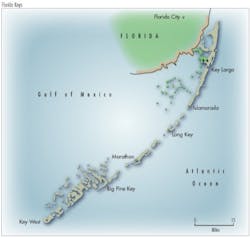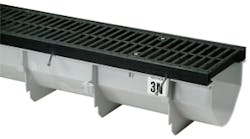Nitrification Control with Monochloramine and Free Ammonia Testing
By Pat Wiese
When a team at Florida Keys Aqueduct Authority (FKAA) set out to eliminate free ammonia in their water in order to control nitrification, the feedback they heard most frequently from colleagues was, “It can’t be done.” But, they found that it can be done, and with minimal changes to the team’s existing routine. By regularly measuring free ammonia, a significant contributor to nitrification, the team has been able to eliminate nitrification events and free chlorine reversions (or chlorine “burns,” as they are often known), and provide award-winning water to their customers.
Nitrification is the two stage biological process of converting ammonia first into nitrite and then into nitrate. Nitrification can occur in drinking water systems containing natural ammonia, in chloraminated systems where free ammonia exists in excess from the chloramination process, or from decomposition of the chloramines themselves.
Even if free ammonia is tied up in the monochloramine formation when it leaves the treatment facility, it is released as the disinfectant attacks bacteria or reacts with organics that generally exist in any distribution system.
The released free ammonia acts as a food source for nitrifying bacteria. This can lead to nitrification and biofilm re-growth in the distribution system. The nitrification and biofilm re-growth process consumes the residual monochloramine disinfectant, generating additional ammonia, which in turn accelerates the nitrification process cycle.
This downward spiral of nitrification can lead to health and regulatory compliance issues beyond those associated directly with the levels of nitrites and nitrates. The most problematic issue for many utilities can be a reduction in total chlorine residuals. Nitrification can result in an increase in heterotrophic plate count (HPCs) and turbidity beyond regulated limits. It can also lead to lower alkalinity and pH levels, which reduce effectiveness of disinfectants and can lead to corrosion in the distribution system.
Beyond the health and regulatory issues, customer taste and odor complaints can result directly from nitrification or from free chlorine reversions used to treat the issue. If uncontrolled, costly and disruptive line flushes may be required.
FKAA Distribution System
FKAA maintains a high quality standard. It has won the “best tasting water in southern Florida” award two years in a row. And, based on concern for customers, it holds itself to a 0.1 mg/L maximum contaminant level goal for nitrite, based on World Health Organization recommendations, even though regulatory limits in Florida allow a maximum contaminant level of 1 mg/L.
FKAA’s water transmission system begins at high-service pumps in Florida City. Water is transmitted about 130 miles to its final destination in Key West. This transmission system provides water to many distribution systems throughout the Keys. The system consists of 182 miles of transmission mains, 690 miles of distribution mains, and 45 MG of treated water capacity.
Due to large system storage volumes, high transit times, and warm water temperatures, FKAA is particularly susceptible to nitrification. Long residence time (the time the water spends in the distribution system between the treatment facility and household faucets) in high temperatures is the biggest factor. In southern Florida, water temperatures are higher than average, perfect for nitrification to occur. This is compounded during the warm summer months, as lighter tourist traffic results in lower demand, and the age of the water in the distribution system increases.
FKAA recently underwent a comprehensive water quality study to better control distribution system nitrification. The following passage from the paper “Nitrification Control in the Florida Keys,” written by Roy Coley, Director of Operations at FKAA, and two colleagues, and presented at the 2010 AWWA Water Quality and Technology Conference, describes the nature of the study:
“FKAA evaluated the relationship between water quality parameters and the onset of nitrification to develop a more proactive nitrification monitoring plan. FKAA tested the standard predictive parameters in addition to monochloramine and free ammonia at its storage, repump, and distribution facilities. FKAA decided to investigate the addition of booster chlorine dosages to combine with the free ammonia to form more chloramines and starve the nitrifying bacteria of their food source.”
Solutions Previously Implemented by FKAA
Addressing nitrification issues requires considerable operational labor and expense. Prior to the study, and the commencement of the current free ammonia monitoring solution, nitrification events required dumping 50 to 100 million gallons of water housed in lines and storage tanks, on average once per year. In addition to the cost of treated water exceeding $100,000 in a flush this large, labor costs were increased due to the need for tracking flow, physically opening and closing valves, and treating the dumped water before discharging. Dumping also put the water supply at risk because empty storage tanks could not be used in the event of a line disruption.
FKAA also used free chlorine reversions to counteract the buildup of nitrification; but this solution led to consumer complaints regarding water taste and odor during the transition period between chloramine and chlorine. This period occurs when chlorine doses are increased to levels that form dichloramine and trichloramine, but have not yet reached the breakpoint where conversion to free chlorine occurs.
Free Ammonia Testing
The industry has traditionally focused on lagging indicators of nitrification, which point to a problem already in progress. The FKAA study found that these parameters (including total ammonia, nitrate, pH, alkalinity, HPCs, and temperature) were not effective in predicting and preventing nitrification.
“If you wait until lagging indicators show up, you cannot successfully get nitrification in check,” Coley notes.
Once nitrification is already in progress, the problem can be solved, but it is unlikely that the water will return to a completely stable value. The solution often involves the flushing of lines or chlorine reversion that results in a foul taste and odor mentioned above. Another issue related to the reversion process is a drop in the protective total chlorine level. This drop occurs when the water is approaching breakpoint just prior to being converted to free chlorine, as indicated by the total chlorine line between Sections II and III in Figure 1. By focusing on the leading indicators of free ammonia and nitrites, and taking action based on their measurements, FKAA is able to avoid these costs and product quality issues.
This focus is managed through four careful measurements in treatment and in the distribution system. In treatment, free ammonia is measured until the level drops below the detection limit as chlorine is added. After values drop below the detection limit for free ammonia, operators continue to add chlorine and then check their monochloramine and total chlorine values. When the values start to separate, free ammonia is zero (see Figure 1). This testing strategy is significant to removing all traces of free ammonia before it enters the distribution system.
To use this method effectively, a system must have the ability to finely control the ammonia feed in treatment. The team had to change its ammonia feed controller in the water treatment plant to establish finer control over ammonia levels. They changed from a traditional rotameter that was too coarse to a mass gas flow controller that had, according to Coley, “an almost infinite level of adjustment.”
In the distribution system, similar measurements are taken. Operators follow a disciplined schedule of measuring free ammonia, total chlorine, and nitrites. When free ammonia levels rise above a designated level of 0.1 mg/L, operators add chlorine at boosting stations at a ratio of 4.5 parts chlorine to 1 part ammonia. This action converts the free ammonia back into monochloramine before it can feed the nitrification process.
For decisions, the team uses Hach benchtop spectrophotometers in the lab, with simple colorimetric tests for the aforementioned parameters. They supplement this testing with field tests using handheld colorimeters.
Operators are certified with the Florida Department of Environmental Protection for Water Treatment and Distribution Systems, which is a requirement for reporting purposes in Florida. They run their own tests at labs in the plant, and at the Stock Island distribution station and a smaller lab on Marathon Island.
The goal in the new procedure is to avoid any buildup of nitrites through routine monitoring and designated action plans. Levels are set for monitoring, alerts, and action. By following this disciplined approach, the team at FKAA is living up to its commitment to eliminate nitrification.
Conclusion
For the new procedure to work, the team had to develop its own procedures to predict the onset of nitrification and aggressively eliminate free ammonia. After a few months of practice, they became successful at maintaining zero free ammonia, and have eliminated the negative effects of nitrification without chlorine reversions or draining their lines. Quite a feat in an area where conditions are perfect for nitrification to occur.
Plant operators were active participants in the change to the new procedure. Coley said that they pushed for change, gathered data used in the study, and recommended actions to take.
“Along the way, everyone became very knowledgeable about the challenges and how to improve water for customers. The operators wanted to do it, and were excited to do it. As results have proved to be beneficial, they have become even more engaged; they are researching online, talking to peers, and testing different techniques,” he said.
The team has passed along its methods via a water quality conference presentation, and through regular contact with engineers and consultants. Operators from other facilities have visited FKAA to observe the procedure.
“When we started this process, people said, ‘You are always going to have some free ammonia in the water; you’ll have to live with it.’ But we have proved this is not true,” Coley said. “People now say, ‘It’s so simple, everyone should be doing it!’”
WW
About the Author: Pat Wiese is a Senior Chemist at Hach Company, based in Loveland, CO. He has 38 years of experience with Hach Company in developing chemical methods and applications for drinking water, wastewater and industrial water analysis. Special thanks to Roy Coley, Director of Operations, Florida Keys Aqueduct Authority, Key West, FL, for his contributions to this article.
More WaterWorld Current Issue Articles
More WaterWorld Archives Issue Articles


